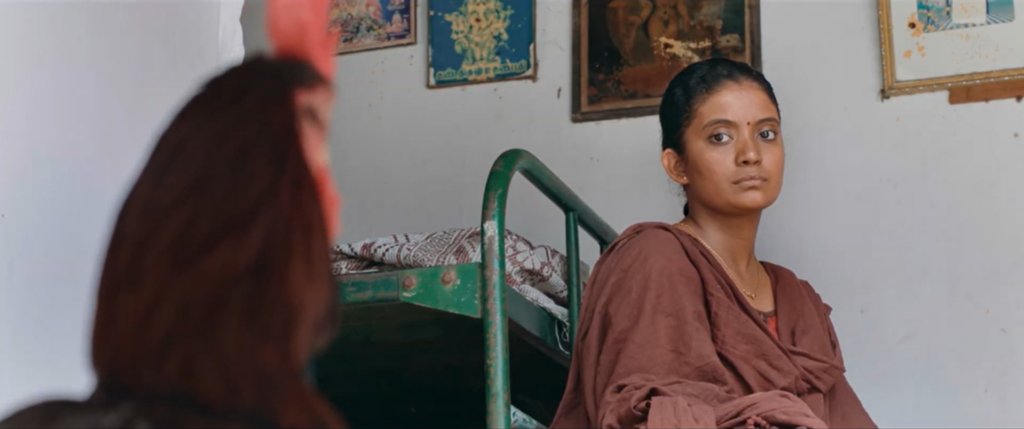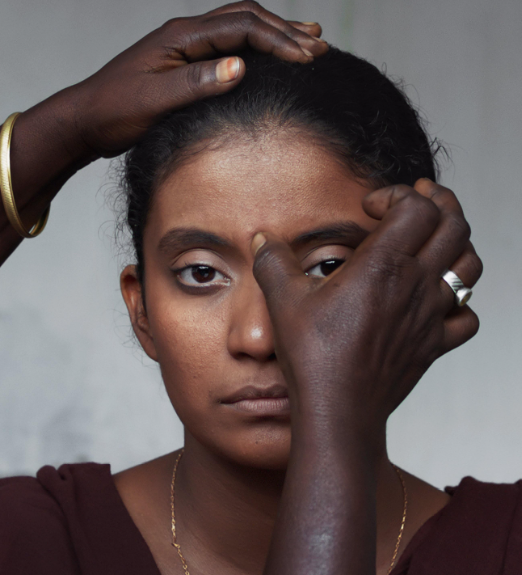
Kottukkaali Is A Homage To Resilience In The Face Of Patriarchal Oppression

The Tamil word “kottukkaali” refers to a young woman who acts according to her own will, but whose actions her family and society consider wrong. Loosely, it translates to “an adamant girl.”
Directed by PS Vinothraj, Kottukkaali (The Adamant Girl) is the story of Meena (Anna Ben), who is taken on a pilgrimage by her family under the pretext of exorcism, to “rid” her of her rebellious behavior: falling in love with a man outside her caste and insisting that she will only marry him. Meena has been customarily betrothed to her maternal cousin, Pandi (Soori).
But having failed to make Meena “forget” her love through physical and verbal violence, her family decides to perform a “cleansing” ritual. Unwillingly taken on a long and uncomfortable journey, Meena is accompanied by her parents, Pandi, his father, two sisters, a young nephew, and a few distant relatives.
The story sets the stage for a deeper examination of the societal constructs at play, prompting critical reflections on oppressive gender norms. Kottukkaali’s unique structure and immersive storytelling reveal the intricate dynamics of familial relationships, particularly through the lens of patriarchy. The film also argues that superstitions function against the interests of women and are, essentially, tools of patriarchal control.

How Power is Consolidated in the Indian Family
The tradition of cross-cousin marriage is still followed in many communities, especially in Tamil Nadu. In this system, young girls are conditioned from a very young age to prepare to marry their maternal cousin, which automatically discourages them from developing romantic interests in other men. This tradition also helps maintain caste purity and consolidate wealth within their clan.
Kottukkaali depicts this phenomenon in Pandi’s family. Pandi has already been betrothed to Meena under their familial traditions. This arrangement ensures that any aspirations Meena may have for a different life or partner are dismissed, thus reinforcing the family’s patriarchal authority. But when Meena chooses to assert her autonomy, and this power structure is threatened, the family deploys terror to re-establish control.
For two weeks, Meena has been subjected to relentless physical violence by Pandi’s family, who have beaten her mercilessly to force her into submission and make her forget her lover. When this eventually fails, Pandi’s sister coldly suggests that Pandi “just break her limbs and tie the sacred thread.”
In her book Pornography: Men Possessing Women (1981), the writer Andrea Dworkin discusses the means through which male supremacy is built and sustained. Power, she writes, “is the capacity to terrorize, to use self and strength to inculcate fear, fear in a whole class of persons of a whole class of persons.” The acts and the symbols of terror coalesce in different combinations, Dworkin adds, “so that terror is the outstanding theme and consequence of male history and male culture.”
In Kottukkaali, a palpable tension prevails throughout the narrative. The plot unravels slowly and we are provided with limited information about the characters. But what cements this tension is the characterization of Pandi, the film’s real protagonist.
Although Pandi’s father is the family patriarch, Pandi enjoys the most power within this system, due to his physical strength and tendency to exhibit terror on everybody else. His furious demeanor makes his unpredictable nature even more unsettling. His silence in Kottukkaali embodies the unspoken violence that perpetuates male supremacy, where terror is an ever-present force rather than a singular event.

Eventually, this terror does erupt. In a pivotal scene in Kottukkaali, Meena faintly hums a song to herself, infuriating Pandi. He is seething with anger at her attitude, upset that she’s unfazed by the havoc she has wreaked by daring to love another man. Up until this point, Pandi has barely uttered a word. But at this moment, his pent-up frustration erupts with terrifying force. The audience is left shocked as Pandi goes on a rampage.
He lashes out at Meena, striking her with uncontrollable fury, and at anyone who attempts to intervene—including his sisters and father. His outburst is very telling of how deeply entrenched patriarchal violence decimates everyone in its path. Pandi’s nephew witnesses these events that will shape his understanding of power and violence, ensuring that the cycle of terror continues to persist. He will inherit all the trauma.
Additionally, Kottukkaali portrays the internalized misogyny among women, through Pandi’s two younger sisters. In one scene, one sister says that this tragedy could have been avoided had Meena been married off to their brother while she was still in school. In another, the family goes to their clan deity’s shrine before performing the ritual. Here, one sister says to the other, who is menstruating, to stay far away from the shrine as she could defile the temple. This diktat, issued by a woman, goes on to show how women also act as agents of misogyny through patriarchal conditioning.
Kottukkaali further criticizes the hypocrisy in how society defines masculinity, using control over women as a marker of real male strength, rather than genuine courage. In one scene, for instance, the men of the family fail to move a bull blocking their path, a task that requires courage and physical strength. Ironically, a small girl, the bull’s owner, steps in and leads it back home.
In another scene in Kottukkaali, Pandi confronts Meena’s father, saying that he should be ashamed of what Meena has done. He adds that had such a thing happened with any of his daughters, Pandi’s father would have been mortified to the point of dying from shame. This mirrors how our collective understanding of masculinity is distorted, centered mostly around how well men are capable of keeping their women “in line.”
Superstitions as Tools of Patriarchal Oppression
Most men in Kottukkaali are shown as deeply devotional and respectful of the traditions passed on to them through their ancestors, regardless of how misogynistic or absurd they may seem. They have pinned all their hopes of Meena forgetting her lover on the “cleansing” ritual. Pandi’s father prays to their ancestors before starting the journey, the auto-rickshaw driver sticks a lemon on a small pitchfork attached to the vehicle, which is branded with a sticker that says “Munusami Thunai” (With the blessings of the Lord Munusami, a local Tamil deity).
Towards the end of Kottukkaali, the family finally reaches the location where the ritual is to take place. They are asked to wait and observe the ritual being performed on another young woman. This young woman’s family, distraught, explains to the priest that she had been in love with someone else but was convinced to marry their son, against her will. Since her behavior has been unusual lately, they say, she must have been possessed by an evil spirit.
The young woman, visibly detached from her surroundings, stands lifeless, her eyes staring blankly into the void. She remains unresponsive as the priest performs the ritual on her. This “cleansing” ritual that Pandi and his family witness is as disturbing as it is nonsensical. The young woman’s family is so deeply mired in superstitious beliefs that they would rather believe an evil spirit has possessed the young woman than confront the harsh reality that she has simply acted per her desires.
Their refusal to acknowledge the real source of her distress—being denied the freedom to marry whom she loved, being forced into a marriage she despises, and having all her dignity stripped away—reflects a collective unwillingness to accept responsibility for perpetuating oppressive social norms. This way, men once again absolve themselves of being the root cause of the problems they perpetrate.

Throughout the journey in Kottukkaali, we see that the landscape is dotted with small shrines of micro-deities, adorned with dried flowers, and draped with torn fabrics—traces of rituals performed over generations. This is a deliberate attempt by the filmmaker to challenge our misconceptions about what we often view as respect for tradition. What is easily misconstrued as devotion, is in fact, patriarchal violence inflicted on women.
The folklore of how such micro-deities came into existence is harrowing. It is said that men who have inflicted violence on a young fetus, infant, or woman install these deities and worship them for generations as a way to repent for their sins and absolve themselves of any guilt.
Narendra Dhabolkar, a popular Indian rationalist and social activist, often emphasized how superstitious practices are not merely personal beliefs, but are used as societal tools to oppress vulnerable groups, especially women. He argued that practices surrounding menstruation, fertility, widowhood, and religious customs often reinforce patriarchal control, and superstitions perpetuate social exploitation, inequality, and patriarchy.
Kottukkaali is ultimately an homage to resilience in the face of patriarchal oppression. All forms of violence have been inflicted on Meena, but this doesn’t deter her. Meena longs for bodily and psychological freedom and is determined to fight for it. Neither will she bow down to the forces ridding her of her rights nor run away when presented with an opportunity to do so. She could be murdered if the ritual doesn’t work, but Meena would rather face the prospect of a dignified death than an empty life devoid of dignity.
In this way, Kottukkaali not only highlights resilience as an admirable quality but also positions it as a vital act of survival against systems that seek to control. Meena’s determination to uphold her dignity, even when facing potentially fatal consequences, reflects a broader struggle for bodily autonomy across cultures, resonating with global struggles for women’s rights.
Kottukkaali has positioned itself as the torchbearer for what will soon be a movement in independent Tamil cinema, where gendered narratives will take center stage.





